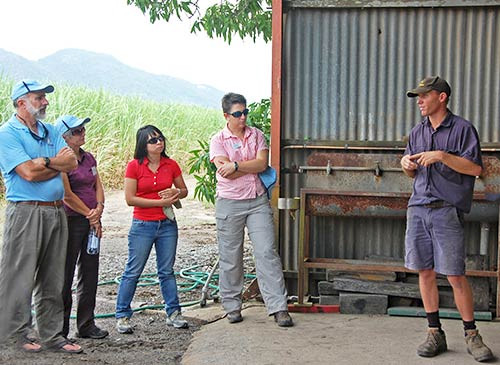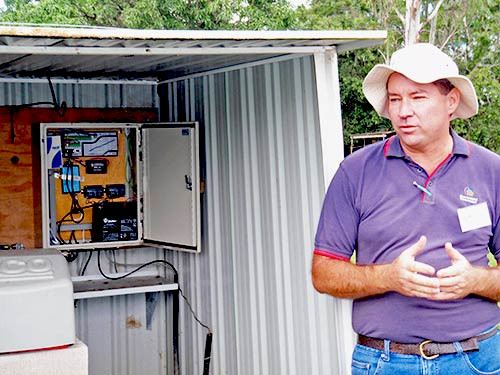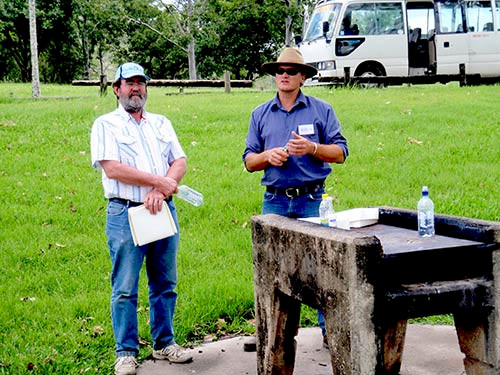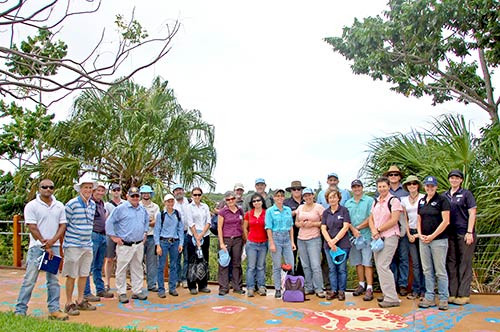Mackay field trip #2: Sugarcane
Bill Dennison ·Rum and coke with peanuts
We went to a sugarcane farm in North Eton operated by two cousins, Lee and Phil Blackburn. They are working with Project Catalyst, which is a Cola-Cola, World Wildlife Fund and Reef Catchments project in which sugarcane producers are experimenting with different ways to grow sugar using less nutrients and pesticides. It was too wet to get to the fields where the experimental plots were located so we met in a shed housing a half million dollar sugarcane harvester (= big lawn mower). Lee explained the different treatment regimes, with different fertilizer and pesticide loading rates using different sugarcane varieties. One of the innovative programs included sugarcane rows interspersed with rows of peanuts. The peanuts are legumes which have bacteria that fix nitrogen in their symbiotic root nodules, thus requiring less nitrogen fertilizer for the adjacent sugarcane plants. One of the issues was that peanuts require more water and have a shorter growing season. Lee explained that the slightly lower sugarcane yield was compensated by lower fertilizer use, so the profit margin was comparable. Since sugarcane is used to make both rum and coke, the peanuts to accompany the rum and coke could be a complementary crop.

The highlight for me was inspecting the harvester, as it was an amazing machine. Lee showed me the tungsten cutting blades that need to be replaced every few hours. The blades cut the cane near the base and the stalks were chopped up into small pieces and separated from the leaves within the harvester. The pieces of sugarcane stalk were transported up a conveyor behind the harvester into a trailing truck and the discarded leaves blown out onto the adjacent harvested areas, which is known as green trash blanketing.
It struck me that driving this machine high above the waving sugarcane plants was akin to driving a trawler over the ocean. Both wheelhouses had high vantage points with a GPS (Global Positioning System), a VHF (Very High Frequency) radio, multiple controls for steering including autopilot, various dials and controls for the cane or fish harvesting gear, and a flock of birds following behind to pick up scraps. Both the harvester and the trawler have creature comforts like air-conditioning, music radios and comfy seats, but require the operator to remain alert and process a lot of information rapidly. They are also inherently dangerous as well. Harvesters can catch on fire and the operator only has about 90 seconds to get out in the middle of a burning cane field. Similarly, trawler operators can very quickly end up in an inhospitable environment (e.g., the middle of the ocean).
We also went to a monitoring site alongside a cane field drain. The monitoring site was part of the Paddock to Reef program which provides data for the Great Barrier Reef report card that the Integration and Application Network team is working on, so it was nice to actually see one of the dots on the maps that Jane Thomas was drawing. There was a V-notch weir to gauge flow with a solar panel powered water quality autosampler housed in a shed nearby. Ken Rohde from Queensland Department of Environment and Resource Management described their sampling regime and results. They used large glass sampling jars to collect integrated samples for pesticides and nutrients. Glass, rather than plastic, is used to avoid pesticides adhering to the walls of plastic containers. A rain gauge which used a tipping bucket was also at the site and since the tipping bucket flips every 0.02 mm of rain, we joked that it had would have started smoking from the friction generated by all the tipping that had occurred during the extraordinary wet weather in Queensland.

Paying for sugar water
At the Kinchant Dam, Brett Anderson from Queensland Department of Environment and Resource Management pointed out how the reservoir worked and also explained the water supply scheme for irrigating the sugarcane fields. The dam is located in a small catchment which is too small to gather enough water, so water is pumped up into the dam from the nearby Pioneer River. Brett used a term for the Kinchant Dam that I had not heard before, a ring tank, which is known as a farm pond in North America. An even smaller water storage unit in Queensland is called a 'turkey nest dam', which is some dirt piled up on the sides of a small pond to retain water. The reservoir is used for recreation and we saw water-skiers on the lake. It is stocked with fish as well. There is a spillway system for controlling water release into a reticulated water irrigation system.

The state of Queensland owns the dam and a corporation named SunWater operates the water supply system. The farmers using the water for irrigation pay for water. The transition that occurred about ten years ago was to go from regulated water to a market based water trading scheme. The original annual fee was about $280 per megaliter and now the price is around $800 per megaliter, but water trading has not been very active due to the weather extremes of drought (nobody wants to give any water away) and flood (nobody needs any water). Obviously a broader geographical range would promote more trading when some areas had more or less water than others.

This is the second of two posts about Bill's participation in a field trip to Mackay, Queensland, Australia.
The first post is:
2. Mackay field trip #1: Lagoons, champions and mangroves
About the author
Bill Dennison

Dr. Bill Dennison is a Professor of Marine Science and Vice President for Science Application at the University of Maryland Center for Environmental Science.

